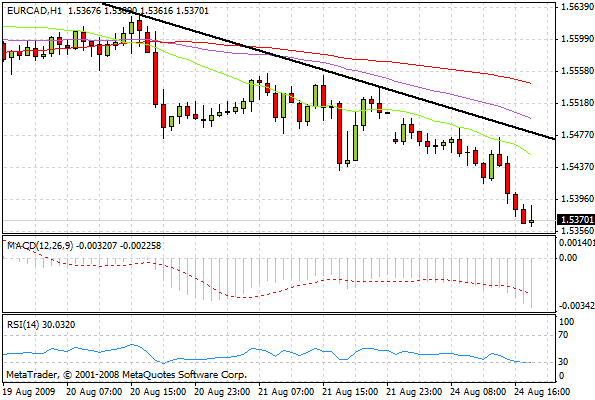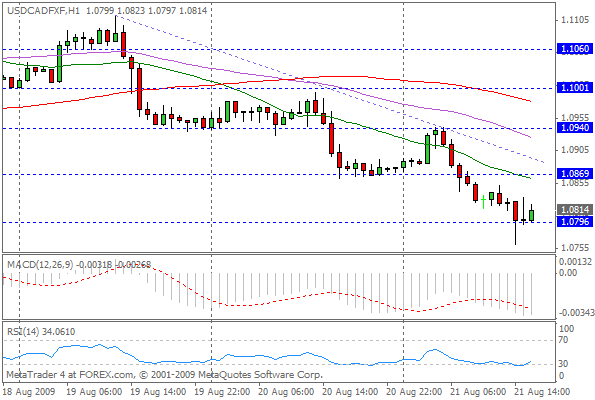Source: ForexYard
Today’s U.S. Consumer Confidence data release is set to dominate the trading between the Dollar and its major currency pairs. A number of other factors are also likely to impact the forex market today, such as the British BBA Mortgage Approvals at 8:30 GMT. The results of today’s data are likely to determine the USD’s trend going into rest of the week’s trading.
Economic News
USD – The U.S Dollar Strengthens Against Most Rivals
The greenback rebounded versus major currencies Monday, from a string of recent declines after signals at the weekend that most key central banks backed a policy of keeping their Interest Rates low for the foreseeable future.
Analysts continue to anticipate that at some point signs of strength in the U.S. economy will be read as positive for the nation’s currency, ending an inverse relationship since the credit crisis began, where negative news triggered safe-haven buying of the U.S Dollar. That relationship still held back the Dollar’s gains on Monday.
The USD also advanced yesterday vs. the EUR and Japanese yen as Wall Street surrendered earlier gains and traders repositioned themselves ahead of U.S. consumer and Housing data due this week. Solid U.S. data and an upbeat assessment on the economy from Federal Reserve Chairman Ben Bernanke over the weekend earlier pushed investors to take on riskier investments at the expense of the low-yielding Yen and Dollar.
EUR – Sterling Pressured; Hits 11 Week Low vs. the EUR
The EUR erased its gains versus the Dollar yesterday as Treasury yields fell and the European Central Bank (ECB) policy makers warned against succumbing to optimism with regard to the economic situation in Europe. The EUR also reversed again versus the Japanese yen after the Euro-Zone industrial orders came in much higher than expected.
But investors are keen to see how the Euro-Zone economy fares, especially after higher-than-forecast purchasing managers’ index readings last week. Traders expect Germany’s Ifo survey of business sentiment to be the key event for the European currency this week.
The British pound dropped yesterday against 14 of the 16 most-traded counterparts on speculation the Bank of England will depress yields on gilts, making the U.K.’s assets less attractive to foreign investors. The Sterling declined yesterday to an 11-week low versus the EUR as much as 0.6%, the weakest level since June 8th. Analysts have said that the EUR was pushed past a key options barrier at 87 pence, setting up further gains in the pair, while traders said expectations for persistently low UK Interest Rates were weighing on the British currency.
JPY – The Yen Advances as Stocks Extend Losses
The Japanese yen was broadly firmer on Tuesday as investors took a pause from a recent rush to stocks and higher-yielding currencies, with focus shifting to U.S. data later in the day for clues on an uncertain economic recovery. The low yielding Yen tends to gain when stocks and higher-yielding currencies fall or when weak economic data highlights a long and uncertain road for global recovery.
The JPY rose against all of the 16 most-active currencies after Atlanta-based SunTrust Banks Inc., Georgia’s biggest lender, said U.S. financial institutions may report more credit losses as commercial real estate falters. Worries are re-emerging that regional and local banks in the U.S. may be facing more loan losses, hence causing risk aversion and buying of the Yen.
Crude Oil – Oil Trades Near 10-Month High on Economic Optimism
Crude Oil prices rose Monday, briefly touching their highest level in 10 months, as optimism about a rebound in the global economy boosted energy prices. The gains came alongside strength on Wall Street, where the stock market also briefly touched 10-month highs before pulling back slightly after a 4 day rally.
Commodities markets have tracked stocks indexes closely in recent months as dealers view equities as a leading indicator of economic performance. Oil dealers said many investors were also using commodities as a hedge against the U.S Dollar, particularly oil, as OPEC producers work to restrain supply.
However, Crude reduced its earlier gains in afternoon trade as U.S. stocks turned lower. With demand remaining weak and supplies standing abundant, the crude market could be ready for a quick and sharp downward movement.
Technical News
EUR/USD
The typical range-trading on the hourly chart continues. The 4-hour chart’s RSI is floating in neutral territory. However, there is a fresh bearish cross forming on the daily chart’s Slow Stochastic indicating a bearish correction might take place in the nearest future. Going short might be a wise choice.
GBP/USD
The cross experienced much bearishness yesterday, and currently stands at the 1.6415 level. There is plenty in the chart’s oscillators that supports a possible bullish correction today. Going long with tight stops may turn out to bring big profits today.
USD/JPY
There is a fresh bullish cross forming on the 4- hour chart’s Slow Stochastic indicating a bullish correction might take place in the nearest future. The upward direction on the daily chart’s Momentum oscillator also supports this notion. When the upward breach occurs, going long with tight stops appears to be preferable strategy.
USD/CHF
The 4-hour chart is showing mixed signals with its RSI fluctuating at the neutral territory. However, the daily Chart’s RSI is already floating in the oversold territory indicating that a bullish correction might take place in the nearest future. When the upwards breach occurs, going long with tight stops appears to be a preferable strategy.
The Wild Card – Crude Oil
Crude Oil prices rose significantly in the last month and peaked at $74.10 per barrel. However, there is a bearish cross on the daily chart’s Slow Stochastic suggesting that the recent upwards trend is losing steam and a bearish correction is impending. This might be a good opportunity for forex traders to enter the trend at a very early stage.
Forex Market Analysis provided by Forex Yard.
© 2006 by FxYard Ltd
Disclaimer: Trading Foreign Exchange carries a high level of risk and may not be suitable for all investors. There is a possibility that you could sustain a loss of all of your investment and therefore you should not invest money that you cannot afford to lose. You should be aware of all the risks associated with Foreign Exchange trading.






